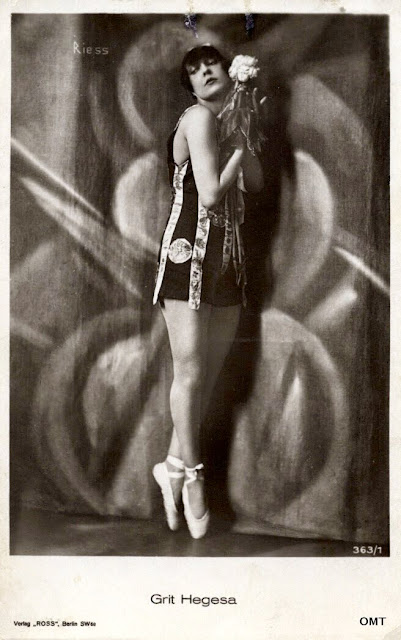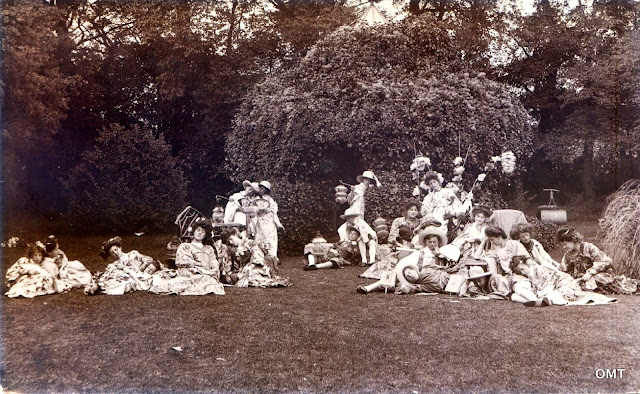“People of
Berlin - people of the world - this is our moment. This is our time.”
Barack Obama, 2008
Between 1924 and 1935 the Ross company (Ross Verlag)
published over 40 000 real photo postcards of European, American and especially
Weimar German actors. It’s surprising then that few film historians have done
work on the company. The most thorough resource can be found on the Ross Cards
website, but what’s missing is the commerce. The company was instrumental in
promoting cinema stars throughout Europe and promotion wasn’t just about
churning out thousands of postcards. It had as much to do with the cultivation
of an image and the presentation of a look. It would be good to know how
closely Ross worked with the studios in creating the image, who bought the
cards and who collected them.
The relationship between Ross Verlag and the film studios
isn’t clear. If Heinrich Ross bought a concession from the studios then the use
of some of the same images by other German companies such as Photochemie
doesn’t make sense. But it doesn’t either that the studios would pay him to
publish postcards when they could do that themselves. If it operated according
to regular publishing models, which vary between countries, the cards were
produced and distributed then percentages were divided up. If that was the case
then Ross had a close role in marketing and could presumably reject some images
for being outside its interest.
What is also noticeable is that cards usually carried the
film studio stamp (UFA, MGM) or the photographer’s but it is unusual to find
both. That suggests that Ross Verlag bought images directly from the
photographic studios. Most surveys of German photography from the era
concentrate on the obvious names, ignoring some studios because it is assumed
they were commercial and don’t represent the avant-garde of German modernism.
Whether the studio principally worked in portraiture or advertising,
familiarity with the new aesthetics was essential. The clients demanded it so
every photographer knew the basic principles. What about the customers? How
much was Ross working to demand and how much was he creating it?
A recent post was devoted to Alex Binder, the photographer
most commonly associated with Ross Verlag but work from studios across Europe
was used. The Ross cards website lists over fifty studios from Berlin alone.
Assuming that most of the actors who sat for portraits were well known enough
to pick the studio, that gives us an idea of how active the business was at the
time.
Below are
examples from some of the Berlin studios most likely to be found on Ross cards.
A couple have long been recognized
as being at the forefront of German modernism and some have recently become the
focus of revived interest. Others remain neglected.
Becker & Maass
One of the unjustly forgotten studios, it was probably
established in the 1870s by Otto Becker with Maass joining as a partner some
time in the 1890s. If Becker was still alive when these cards were produced he
had been in the business for fifty years. More likely then a family member
inherited the business or its success meant that new owners kept the name.
The Becker & Maass name appears on Sterne cards, the
precursor to Ross, and early Ross Verlag cards, C1925 but not in the 1930s. It
has one of the most distinctive styles. Strongly influenced by the soft focus
painterly style of Pictorialism, Becker & Maass avoided the sweet,
wholesome look some film studios preferred. Ross cards often hinted at
eroticism while very, very rarely being explicit but Becker & Maass
suggested something even more troublesome; the independent, self-possessed
woman.
Emil Otto Hoppé
(1878-1972)
Hoppé was the most famous photographer whose work appeared on
Ross cards, as well known in the 1930s as he is today as a leading figure in
German modernism. The British also lay claim to him as he lived and worked in
London throughout the 1920s and ‘30s but for my money the most interesting book
of his work is devoted to his Australian photographs taken in 1930. He
travelled across the country, from Tasmania to the Northern Territory and
Queensland, the south-west forests to the central desert at a time when these
regions were only barely connected to one another. The Australian photographers
he met, like Harold Cazneaux, were still excited by ideas that had become
outdated a generation earlier. His celebrity portraits however are rarely
exceptional. You could argue the difference between this portrait of Lucy
Doraine and one Alex Binder might have taken but the distinction is fine. It is
clear however that whoever took it was astutely professional.
Angelo Photos
Pál Funk (1894-1974) is better known today in his native
Hungary than outside of it though in the 1930s he was recognized as one of the
most prominent studio photographers throughout Europe. His connections through
work with Hoppé, Leopold Reutlinger and Rudolph Dührkoop and as a cinematographer for Michael Curtiz are impressive as is
the list of awards bestowed on him in his later years. These days it is his
highly stylized Pictorialist nudes that are most sought after. You can see why
in this study of Vilma Banky. Few studio photographers really understood that
artificial lighting was meant to evoke rather than expose. Funk did.
Frieda Riess (1890 - C1955)
It’s surprising how many rediscovered photographers weren’t
lost at all. Everything; photographs, documents, biographical information is
there, waiting for someone to eventually give it some attention. There has been
a revival of interest in Reiss lately, in Germany at least, with a biography
and a major exhibition at the Berlinische Galerie. When you consider her
sitters included Einstein, Mussolini, Josephine Baker and Jack Dempsey, her
social connections extended through Berlin’s art world and she worked as the
stills photographer on Fritz Lang’s films, you could wonder why she doesn’t
rate a mention in histories of German photography until recently. Part of that
was through her design. Around 1930 she married the French ambassador, Pierre
de Margiere, and moved to Paris, retreating from photography and Berlin
society. Note the abstract design
on the backdrop in this portrait of dancer and actress Grit Hegesa. There are
several portraits of dancers Reiss took against such backdrops but it is hard
to say whether they were part of a series or if she just liked the effect.
Karl Schenker
(C1880-C1952)
Around 1930, Schenker took a series of fashion portraits of
store mannequins carefully painted and arranged so that at first glance it is
easy to mistake them as real women. Schenker is another who apparently
disappeared from view. His work never appears in the surveys of German
photography despite adjectives such as ‘famous’ and ‘highly regarded’ occurring
before his name. Like a lot of the photographers here, his best known works
today are his Pictorialist nudes. Here’s the problem. Having been away from the
spotlight for so long, you might think his return would excite more interest:
who was this photographer who took these extraordinary nudes? Unfortunately for
Schenker the world is awash with Pictorialist nudes and if he was something of
a radical experimentalist in 1913 he no longer is.
Atelier Manassé
Polish couple Adorján von Wlássics (1893 - 1946) and Olga Spolarics (1896 - 1969) began the Manassé studio in Vienna during the 1920s and relocated to Berlin in the late 1930s. Maybe they tired of Pictorialist nudes early on because although the erotica is their best known work it is highly surreal; women in birdcages, crawling out of snail shells, trapped in bottles, pursued by giant beetles – you get the idea. Monika Faber published a book of the studio’s surrealist images, Divas and lovers: the erotic art of Studio Manassé, in 1998.
Ernst Schneider
If a single magazine represented Weimar Germany it was Berliner Zeitung Illustrirte. Not as
experimental with graphics as its later rival AIZ (Arbeiter Illustrierte Zeitung) it was still the place to get your work seen
and most photographers here had images appear in it, including Ernst Schneider.
In 1908 he published The Human Form
and Beauty: templates to study the naked human body, which as the
title suggests was erotica wearing the thinnest gauze to disguise itself as art.
It came out just after Heinrich Pudor published Nacktkultur in three volumes, which espoused the virtues of nudity,
vegetarianism and racial purity. Historians can’t help but make the association
between books like Schneider’s and the rise of Nazism.
Martin Badekow
(1896-1983)
These days a vintage print by Badekow will set you back a few
hundred dollars but you can still buy a Ross real photo postcard for the price
of a bus fare. Overlooked for a long time, his photographs from the Berlin
cabarets have become emblematic images of Weimar Germany. Like Funk and Reiss
he is frequently referred to in the press of the time as famous or world
renowned yet post-war he disappeared from the radar. Today, with the increasing
interest in fashion photography, it would be an oversight to leave him out of
an exhibition.
Balázs Studio
Nothing can be found about this studio despite its work
appearing frequently on Ross cards. Balázs is a common Hungarian surname and
Berlin in the 1920s was full of émigrés from central and eastern Europe who had
either escaped for political reasons or had moved to where the money and the
ideas were. Considering how popular a lot of the actors were when they sat for
the studio it must have had a good reputation, in a city full it seems of world
class photographers.
 |
| WEIMAR PHOTO STUDIOS |






















